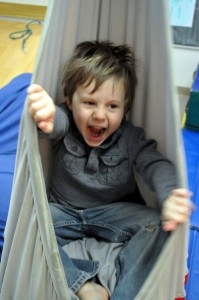We all want our children to be happy, learn, be successful and be able to adapt to their ever changing environment, but this can often be challenging.
In order to begin to understand attention, arousal and behavior, it is necessary to understand sensory processing. Sensory Integration was a theory developed by A. Jean Ayres based on her knowledge of neuroscience and occupational therapy. “Dr. Ayres developed sensory integration theory to better explain the relationship between behavior and neural functioning, especially sensory processing or integration. Her goal was to develop a theory to describe and predict the specific relationships among neural functioning, sensorimotor behavior and early academic learning.”
Dr. Ayres states, “Sensory integration is the organization of sensation for use. Our senses give us information about the physical conditions of our body and the environment around us. Sensations flow into the brain like streams flowing into a lake. Countless bits of sensory information enter our brain at every moment, not only from our eyes and ears, but also from every place in our bodies. We have a special sense that detects the pull of gravity and the movements of our body in relation to the earth.” (The vestibular system)
“The brain must organize all of these sensations if a person is to move and learn and behave normally. The brain locates, sorts, and orders sensations – somewhat like a traffic policeman directs moving cars. When sensations flow in a well-organized or integrated manner, the brain can use those sensations to form perceptions, behaviors, and learning. When the flow of sensations is disorganized, life can be like a rush-hour traffic jam.”
To maintain appropriate attention to tasks it is necessary to be able to self-regulate. This allows us to adapt to the changing demands of the environment. We are the most productive in the calm-alert state, but have moments when we are either tired, distracted, anxious or excited, and have difficulty staying focused. As adults we have the freedom to seek out whatever will help us to self-regulate, but children do not always have this freedom and therefore we need to provide them the opportunities as well as the activities to help them maintain an optimal arousal state.
Regulation
Regulation of arousal and physiological state begins at birth and is critical for the child to be able to adapt to it’s ever changing environment. The question of a child’s temperament may also be attributed to their ability to self-regulate. The behavioral indicators of poor self-regulation and difficult temperament overlap. It is important to distinguish children who have sensory integration dysfunction from those with regulatory disorder. Although many children with regulatory disorders also have poor sensory processing and motor planning problems, not all children with sensory integrative dysfunction have a regulatory disorder. Behavioral indicators of children with a more significant regulatory disorder may be emotional ups and downs, irritability, difficulty with transitions or unexpected changes, inattention, sleep problems, feeding problems, and mood regulation problems, and sensory processing problems.
Arousal refers to our ability to maintain an optimal performance level and how alert we are in order to sustain our attention and complete tasks as the environment demands. Self regulation is our ability to achieve, sustain and change our arousal level to meet the changing demands of the task or situation. As a child matures they develop strategies they find will help them to maintain attention, and some are not always appropriate if there are regulatory issues. With adequate self regulation the child will be able to develop and refine strategies unconsciously.
“Self-regulation strategies that require higher level cognitive skills for problem solving, self-monitoring, recognition of need for arousal state change or maintenance, language for organization, planning, sustained attention, working memory, organization of spaces, time, tasks and environments, choice of goals, intention, and the formulation, execution and evaluation of strategies, do not usually appear until the age of 8 years.”
Difficulty with regulation may make it difficult for some children to get up in the morning or to fall asleep at night. They are unable to “shift gears”. With an understanding of their sensory processing, strategies can be developed to help them through the process.

